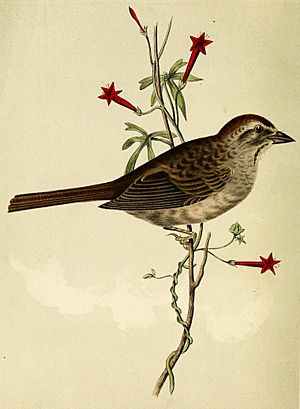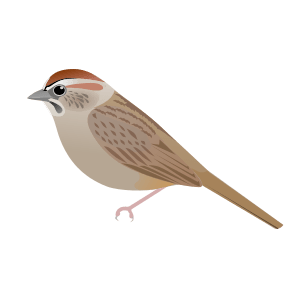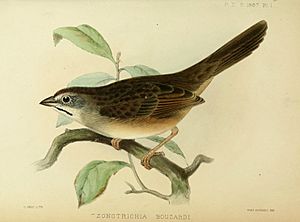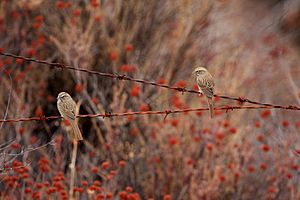Rufous-crowned sparrow facts for kids
Quick facts for kids Rufous-crowned sparrow |
|
|---|---|
 |
|
| Aimophila ruficeps eremoeca, in Mill Creek Rd, Fremont California | |
| Conservation status | |
| Scientific classification | |
| Genus: |
Aimophila
|
| Species: |
ruficeps
|
| Subspecies | |
|
See text |
|
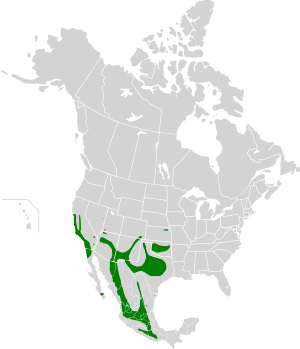 |
|
| Range of A. ruficeps resident populations | |
| Synonyms | |
|
Ammodramus ruficeps |
|
The rufous-crowned sparrow (Aimophila ruficeps) is a small American sparrow. These birds live mostly in the Southwestern United States and a large part of Mexico. They are found south to the transverse mountain range and west to the Pacific coast. Their homes are often spread out, with groups living far from each other.
This sparrow has a brown back with darker lines and gray feathers underneath. Its head has a reddish-brown (rufous) crown, which gives it its name. Its face is gray with a brown or rufous stripe from each eye. It also has a thick black stripe on its cheek.
Rufous-crowned sparrows eat mostly seeds in winter. In spring and summer, they eat insects. These birds often protect their space. Males sing and show off to guard their territory. They are not good at flying and prefer to hop on the ground. They have one mate for life and breed in spring. They lay two to five eggs in a hidden, cup-shaped nest. Cats and small hawks hunt adult sparrows. Young birds can be caught by mammals and reptiles. They can live for over three years. This bird is listed as least concern, meaning it is not threatened. However, some types of this sparrow are in danger because their homes are being destroyed. One type might even be gone forever.
Contents
About the Rufous-Crowned Sparrow
This bird belongs to the Passerellidae family, which includes American sparrows. American sparrows are New World birds that eat seeds. They have cone-shaped beaks, brown or gray feathers, and special patterns on their heads.
Birds in the Aimophila group are usually medium-sized, about 5 to 8 inches (13 to 20 cm) long. They live in dry, bushy areas. They have long beaks and tails compared to their bodies. Their wings are short and round. They build cup-shaped nests.
The rufous-crowned sparrow was first described in 1852 by John Cassin, an American bird expert. He called it Ammodramus ruficeps. The name Aimophila comes from Greek words meaning "thicket-loving." The name ruficeps comes from Latin words meaning "reddish head." People sometimes call it the "rock sparrow" because it likes rocky hills.
Different Types of Rufous-Crowned Sparrows
There are usually 12 types, or subspecies, of the rufous-crowned sparrow. Sometimes up to 18 are named. Here are some of them:
- A. r. ruficeps: This type was described in 1852. It lives in California's coastal mountains and the western Sierra Nevada. It is darker and smaller than A. r. eremoeca.
- A. r. canescens: Found in southwestern California and northern Baja California. This type is listed as a "species of special concern" in California. This means it is threatened with extinction.
- A. r. obscura: Lives on the Channel Islands of California. It is similar to A. r. canescens but darker.
- A. r. sanctorum: This type lived on the Todos Santos Islands off Baja California. It is believed to be extinct. It was the darkest of the coastal types.
- A. r. sororia: Found in the mountains of southern Baja California. It is the lightest of the coastal types.
- A. r. scottii: Lives from northern Arizona to New Mexico and south into Mexico.
- A. r. rupicola: Found in the mountains of southwestern Arizona. It looks like A. r. scottii but is darker and grayer.
- A. r. simulans: Lives in northwestern Mexico. It has more reddish-brown color on its back.
- A. r. eremoeca: Found from southeastern Colorado to New Mexico, Texas, and parts of Mexico. It has grayish upper parts and a dark chest.
- A. r. fusca: Lives in western Mexico. It is darker and more reddish-brown on its upper parts.
- A. r. boucardi: Found in eastern Mexico. This type is darker than A. r. eremoeca.
- A. r. australis: Lives in southern Mexico. It is smaller than A. r. scottii and has a shorter beak.
Appearance
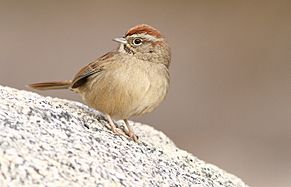
The rufous-crowned sparrow is a small bird, about 5.25 inches (13 cm) long. Males are usually bigger than females. They weigh about 0.5 to 0.8 ounces (15 to 23 grams).
It has a brown back with darker stripes and gray feathers underneath. Its wings are short, round, and brown, without any wingbars (lines of contrasting feathers). The tail is long, brown, and rounded. The face and the area above the eye (supercilium) are gray. There is a brown or rufous stripe from each eye and a thick black stripe on each cheek.
The top of its head, or crown, is reddish-brown or chestnut. This is how it got its name. Some types have a gray stripe down the middle of the crown. Its beak is yellow and cone-shaped. The throat is white with a dark stripe. Its legs and feet are pink-gray. Both male and female sparrows look similar. Young sparrows have a brown crown and many stripes on their chest and sides in spring and autumn.
The sparrow's song is a short, fast, bubbling sound of "chip" notes. These notes can get faster near the end. Its calls include a nasal "chur" and a thin "tsi." When it feels in danger or is separated from its mate, it makes a "dear-dear-dear" call.
Where They Live and Their Home

This bird lives in the southwestern United States and Mexico. It can be found from sea level up to 9,800 feet (3,000 meters) high. But it usually lives between 3,000 and 6,000 feet (900 and 1,800 meters). It lives in California, southern Arizona, southern New Mexico, Texas, and central Oklahoma. It also lives along Baja California and in western Mexico.
In the central United States, it is found as far east as a small part of western Arkansas. It also lives in a small area of northeastern Kansas. The places where this sparrow lives are not continuous. They are made up of many small, separate groups. The rufous-crowned sparrow does not migrate. However, the mountain types might move to lower places during very cold winters. Male sparrows protect their territories all year long.
This sparrow lives in open oak forests and dry uplands. These areas have grassy plants and bushes. It is often found near rocky areas. The bird also lives in coastal scrublands and chaparral areas. The rufous-crowned sparrow does well in open spaces that have been cleared by fires.
Life and Behavior
The average size of a rufous-crowned sparrow's territory in California's chaparral is about 2 to 4 acres (0.8 to 1.6 hectares). Usually, one pair of sparrows lives in a territory. However, sometimes a bird without a mate might share a territory with a pair.
This sparrow is not very good at flying. It mostly moves by running and hopping on the ground. Rufous-crowned sparrows sometimes look for food in pairs during breeding season. In late summer and early autumn, they forage in family groups. In winter, they can sometimes be found in loose groups with other bird species.
Adult sparrows are hunted by house cats and small hawks. These include Cooper's and sharp-shinned hawks, American kestrels, and white-tailed kites. Nests can be attacked by mammals and reptiles like snakes. Sparrows have special ways to trick predators. They might do a "rodent run," where they run fast with their head, neck, and tail low. They might also do a "broken wing" display. Here, they pretend to have a broken wing to lead the predator away from the nest. Another trick is "tumbling off the bush." The bird falls from a bush to attract the predator to itself.
The longest a rufous-crowned sparrow has lived is three years and two months. Two types of ticks can live on the sparrow.
Diet
This sparrow mainly eats small grass and forb seeds. It also eats fresh grass stems and soft plant shoots in autumn and winter. During these seasons, it eats a few insects like ants, grasshoppers, and spiders. In spring and summer, it eats more types and amounts of insects.
The rufous-crowned sparrow looks for food slowly on or near the ground. It walks or hops under bushes or thick grasses. It almost never looks for food in open areas. Sometimes, it has been seen feeding in branches and low bushes. During breeding season, it picks food from grasses and low bushes. But usually, it gets food by pecking or scratching at fallen leaves. This bird tends to look for food in small family groups in a small area.
It is not known if this bird gets all its water from its food. But it has been seen drinking and bathing in puddles after rain.
Reproduction and Life Cycle
The rufous-crowned sparrow breeds in bushy areas with not much plant cover. Males attract a mate by singing from special spots at the edge of their territories. They sing throughout the breeding season. These birds are monogamous, meaning they have only one mate at a time. Pairs often stay together for several years. Males protect their territories all year.
The female bird builds a large, thick, cup-shaped nest. It is usually on the ground, but sometimes in a low bush up to 18 inches (46 cm) high. She uses dried grasses and roots. Sometimes she adds strips of bark, small twigs, and weed stems. Nests are well hidden near bushes, tall grasses, or overhanging rocks. Once a sparrow picks a nesting spot, it often returns to it for many years.
She lays between two and five eggs at a time. They usually raise one group of young birds a year. But some birds in California have raised two or even three groups. If a nest fails, they might lay new eggs. The eggs are plain, pale bluish-white. Sometimes, brown-headed cowbirds lay their eggs in the sparrow's nest, which is called brood parasitism.
The female sits on the eggs for 11 to 13 days. The baby birds hatch naked. Feathers start to show on the third day. Only females sit on the nestlings. But both parents bring whole insects to their young. When a young sparrow leaves the nest after eight or nine days, it cannot fly yet. But it can run through the bushes. The parents still feed it during this time. Young birds usually leave their parents' territory in autumn or early winter. How well they reproduce depends a lot on how much rain there is. They have more success in wet El Niño years. This is because cool, rainy weather makes snakes, their main predators, less active.
Conservation
BirdLife International lists the rufous-crowned sparrow as a species of least concern. This means it is not threatened with extinction. This is because it lives in a large area, about 463,323 square miles (1.2 million square kilometers). Its population is estimated to be 2.4 million birds. Also, its population has not dropped by 30% in the last ten years.
In years without enough rain, many birds do not breed. Those that do have fewer young. Some local groups of this bird are in danger and their numbers are going down. The types that live on islands have decreased in some cases. The A. r. sanctorum type from the Todos Santos Islands is thought to be extinct. The groups on Santa Catalina Island and Baja California's Islas de San Martin have not been seen since the early 1900s.
Sparrow groups in southern California are also losing their homes. This is due to cities growing and farms expanding. Also, the sparrow has been poisoned by a rat poison called warfarin. More study is needed to see how pesticides affect the rufous-crowned sparrow.
Images for kids
See also
 In Spanish: Chingolo coronirrufo para niños
In Spanish: Chingolo coronirrufo para niños



